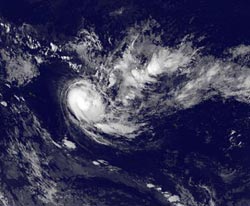NASA sees Tropical Cyclone Garry continue to intensify

NOAA's GOES-15 satellite captured this infrared image of Tropical Storm Garry about 330 miles east of Pago Pago, American Samoa. The image was taken Jan. 24 at 1500 UTC (10 a.m. EST). The bright white circle of clouds are strong thunderstorms wrapping around the center of circulation as Garry continues to intensify.<br><br>Credit: NASA's GOES Project<br>
NOAA's GOES-15 satellite captured an infrared image of Tropical Storm Garry when it was located about 330 nautical miles (379.8 miles/ 611.2 km) east of Pago Pago, American Samoa. The image, created by the NASA GOES Project at the NASA Goddard Space Flight Center in Greenbelt, Md., was taken Jan. 24 at 1500 UTC (10 a.m. EST).
The image showed a bright white circle of clouds that indicate strong thunderstorms were wrapping around the center of circulation as Garry continues to intensify. The latest bulletin from the Joint Typhoon Warning Center noted that microwave satellite imagery confirmed deep convection wrapping almost entirely around Garry's well-defined low level circulation center.
NOAA's GOES-15 satellite is in a fixed orbit over the Pacific Ocean, midway between Hawaii and the West Coast and 22,300 miles above the equator. GOES-15 provides a good view of what is happening in U.S. west and in the Pacific Ocean.
On Jan. 24 at 0900 UTC, Garry's maximum sustained winds had increased to 60 knots (69 mph/111.1 kph). Garry's tropical-storm-force winds extend about 55 nautical miles (63.3 miles/102 km) from the center, making it a compact tropical cyclone. It was centered near 14.0 south latitude and 164.9 west longitude and moving to the southeast at 11 knots (12.6 mph/20.3 kph).
Forecasters at JTWC expect that Garry will continue moving southeast and is expected to pass far south of French Polynesia. Garry is expected to briefly reach cyclone (hurricane) strength before wind shear weakens and dissipates the storm.
Media Contact
More Information:
http://www.nasa.govAll latest news from the category: Earth Sciences
Earth Sciences (also referred to as Geosciences), which deals with basic issues surrounding our planet, plays a vital role in the area of energy and raw materials supply.
Earth Sciences comprises subjects such as geology, geography, geological informatics, paleontology, mineralogy, petrography, crystallography, geophysics, geodesy, glaciology, cartography, photogrammetry, meteorology and seismology, early-warning systems, earthquake research and polar research.
Newest articles

A universal framework for spatial biology
SpatialData is a freely accessible tool to unify and integrate data from different omics technologies accounting for spatial information, which can provide holistic insights into health and disease. Biological processes…

How complex biological processes arise
A $20 million grant from the U.S. National Science Foundation (NSF) will support the establishment and operation of the National Synthesis Center for Emergence in the Molecular and Cellular Sciences (NCEMS) at…

Airborne single-photon lidar system achieves high-resolution 3D imaging
Compact, low-power system opens doors for photon-efficient drone and satellite-based environmental monitoring and mapping. Researchers have developed a compact and lightweight single-photon airborne lidar system that can acquire high-resolution 3D…





















